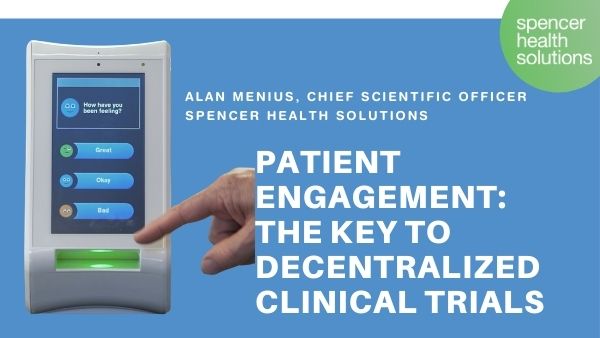By Alan Menius, Chief Scientific Officer, Spencer Health Solutions

Patient Engagement: The Key to Decentralized Clinical Trials
A year into the pandemic, the clinical trials world is coming to grips with long-term changes in the way trials are developed and conducted. These changes, led by the move to remote and decentralized clinical trials, present a great opportunity to improve research and outcomes – but only if we start by improving patient engagement.
COVID-19’s effects on clinical trials are well-documented. Enrollments are down, patient visits to trial sites aren’t happening as often, and some investigators have been furloughed or reassigned to COVID-related duties. For many reasons, the way clinical trials are conducted has not kept pace with changing economic, demographic and cultural norms.
The good news is that trial sponsors and researchers have begun to embrace new methods. These include decentralized trials, defined by the Clinical Trials Transformation Initiative as those conducted by telehealth and mobile providers.
However, as more trials move away from traditional settings, sponsors need to make sure they’re ready to confront the challenge of keeping patients engaged in their own health. Rather than being a barrier to overcome, improving patient engagement should be seen as an opportunity made possible by technology and process improvements.
Better Engagement = Better Adherence
High levels of patient engagement in clinical research is known to be equated with higher medication adherence. So it’s vital that participants play a collaborative role and remain engaged with their care team.
While the industry continues to learn more about engaging patients during trials, we can count on several broad principles to design and conduct trials that result in high levels of engagement. For example, connecting with patients in ways they want to be reached, and with the right information, helps reduce frustration and lead to better engagement.
In a new whitepaper, Spencer Health Solutions outlines four examples of ways trial sponsors can better engage participants in remote or decentralized trials:
Deploy custom surveys: One way to gather both qualitative and quantitative data from patients is to ask them directly about their health status, medications taken and any symptoms. The white paper describes how Catalyst Healthcare has used spencer in-home units to give pharmacists patient-reported details from survey questions delivered over spencer.
Collect real-world data passively: Real-world data (RWD) is gaining in usage. By adding passive biometrics to electronic health records and digital health devices, researchers can collect the data needed to report real-world evidence (RWE) without requiring patients to act.
Provide content that motivates healthy behaviors: Patient portals are often effective in delivering health messages and reminders.
Improve safety: If a patient suddenly stops taking medication, the medical team can find out about it in near-real-time with devices that track daily adherence levels. These digital patient engagement tools feed data to researchers that can help them address medication safety issues.
Use Technology Strategically
These examples of ways to improve engagement in decentralized trials have technology solutions at their core. But successfully engaging patients requires far more than providing them with technology and tools. Each digital health technology must be deployed strategically, taking into account whether and how patients interact with the tools and whether the chosen technology actually helps bring about high-quality studies.
For example, patient portals that are well-designed and easy for patients to use are great tools for increasing engagement. However, studies show that mobile health apps are better used as support platforms, not as a primary or exclusive means of interacting with patients. A good strategy for designing a trial is to select the right patient portal and use mobile apps that support engagement through the portal.
One advantage that in-home technology offers for decentralized trials is the ability to track and report biometrics, enable patient surveys, and perform other functions via telehealth that previously required a visit to the clinic site. A May 2020 Viewpoint article in JAMA listed multiple methods of collecting patient information remotely, including at-home electronic data capture, centralized data monitoring, and the use of local labs instead of central ones used during trials. These methods should be here to stay, even after the pandemic recedes.
In recent years, clinical trials have depended more on digital health technologies to perform a variety of functions, including improving patient engagement. COVID has only accelerated that trend.
As decentralized trials become more the norm than the exception, trial sponsors have a great opportunity to rethink what it means to engage patients and make sure engagement is at the top of the list when designing and implementing their studies.
